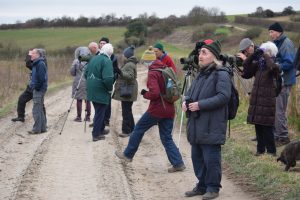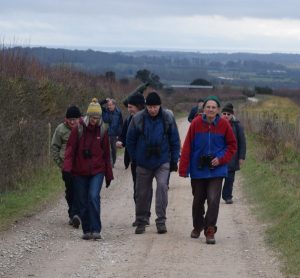An excellent turnout of 22 members from Ferring Conservation Group set out from the beautiful village of Burpham led by their knowledgeable guide, Clive Hope. Their aim was to observe the diverse and plentiful wildlife this relatively remote area of south-east England has on its doorstep.
This village is built on the side of Perry Hill just out of reach from the flood plain. Therefore wonderful views are apparent for the eye to see with Arundel Castle in the distance to the south west, and views towards the gap in the Downs where the river Arun carves its way to the sea to the north west.
The Group made their way to the large Saxon Burgh on which part of the village stands and this fortification was an ideal place to view farmland birds as well as a range of raptors. As the Group set off several Red Kites and a solitary Sparrow hawk were circling high above joined by a large Buzzard, all greatly defined against the dark grey clouds. A small flock of noisy Guinea fowl were spotted in a farmer’s field with a few Sparrows and Wood Pigeons for company. Two Grey partridge were seen foraging for food in a nearby field, a welcome sight, with their numbers greatly increased by a breeding programme started back in 2003 on the Duke of Norfolk Estate. Further along the track a single Green Finch sat perched on the top of a small tree while several Stock Doves were foraging for food nearby. Unlike most pigeons and doves the Stock Dove nests in holes, usually in trees, but often in old stone barns or similar buildings. Unlike the Woodpigeon it has no white feathers in its plumage and is smaller and shorter-tailed.
As the Group progressed along the route more Red Kites gathered above and were joined by Common Gulls, a small number of Black-headed Gulls and some Starlings. A keen eyed member of the Group spied two Brown Hares ‘boxing’ in the middle of a field. These displays are an exhibit of mating behaviour – although a little early as this usually starts in March. It is surprisingly the females who instigate ‘boxing’ as a way to fend off the mating urges of the males!
The countryside views were enhanced with the sighting of a quaint shepherd’s hut in the corner of a field and a couple of dew ponds suitably located for use by livestock, also, the group witnessed strategically placed winter supplementary feeding stations for seed-eating farmland birds.
As Members made their way back to their starting point 20 or so Corn Buntings were seen perched along the top of a row of saplings. Encouraging signs of spring were apparent with the sound of Sky larks in the distance, hawthorns just coming into leaf and Lords-and-Ladies plants peering out along the edges of the hedgerows. All welcome reminders of warmer days to come and a chance to explore the countryside further.
